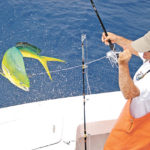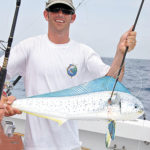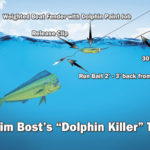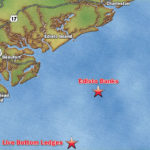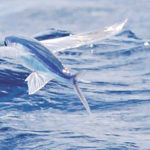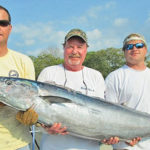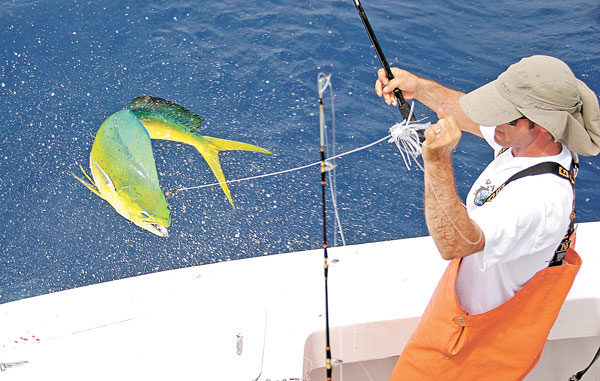
Dolphin fill the bill along South Carolina’s southern coastline.
After a 3:45 a.m. wake-up call and a 4:30 departure from the dock, it was a 3-hour run to the blue water. On the long ride out, daylight broke, and not long into the first pull of the morning, a buzz-like lightning went through the boat as the captain and crew — all of whom have keen eyesight above and beyond that of mortal men — spotted “something” following the baits.
In a flash, one of the lines released, and the rod went bowed over. In the boat’s deep-blue wake, an emerald green and yellow torpedo broke through the churning foam and vaulted skyward. No question about it, this was a magical place, a sea where dolphins fly.
For Capt. Jim Bost and most other charter captains who ply the waters off South Carolina’s southern coast, offshore trolling is a multi-faceted tactic that has an appeal for many species of fish. The standard practice is to rig a number of baits, ranging from ballyhoo to feather jigs, and including a wide variety of set-ups, rigging, and presentations. Most fishermen consider outriggers an integral part of the scenario, and Bost will run as many as eight baits behind and tethered to the projecting framework on either side of the boat.
“My standard fare is 30-pound tackle; the baits I use are also pretty standard, either naked ballyhoo, Sea Witches or Ilanders in either blue and white or pink and white,” said Bost (843-631-0810). “With this type of trolling set-up, we’ll catch just about anything that roams (the) bluewater: wahoo, blackfin tuna, yellowfin and even billfish.”
The Gulf Stream is home to a number of pelagic species, including marlin, sailfish, tuna, and wahoo. However, during June, dolphin — or mahi-mahi, if you prefer — are the most-consistent of the top-drawer offshore gamefish and are highly targeted by many anglers along the coast. Famous for their aerial acrobatics when hooked, their speed and agility make them an exciting catch, not to mention tasty.
A fish common to warmer waters, dolphin are usually found in deep waters, close to the surface, and they are attracted to any type of bottom relief or surface clutter.
“A normal charter means leaving the dock at 4:30 (a.m.), taking a bearing from the A-Can off the mouth of the South Edisto River and heading 45 miles out toward the Gulf Stream,” said Bost. “That’s where the best bottom structure is and where I’m most likely to come across weeds or debris that will attract fish.”
Dolphin are known as voracious predators. While their favorite prey is flying fish, they also eat squid, shrimp, crustaceans and even smaller dolphin. Their keen eyesight helps them locates most of their food near clumps of floating vegetation and debris, and they are considered the most surface-oriented of all bluewater gamefish.
“Dolphin are surface feeders and are attracted to debris, weeds or any type of clutter that catches their attention,” Bost said. “Sailfish, blue marlin and wahoo are also likely to check out this type of structure.”
One of the most obvious “signs” of life in the offshore waters is commonly referred to as “weeds.” The majority of offshore weeds are Sargasso grass or sargassum, a type of floating brown algae that has a main stem with flattened outgrowths like leaves that contain air sacs to keep the plant afloat. The algae is coated with a sticky substance to help keep the individual plants together in heavy currents, which results in a surface mat that plays host to a wide variety of plant and animal life, creating an ecosystem all to itself.
“Hopefully, once we get out into the bluewater we’ll start seeing weeds,” Bost said. “I don’t find weeds on every charter, but if they’re there, you need to fish them. It’s like fishing lily pads for bass; it’s a place for baitfish to hide and predators to seek them out. The next-hardest thing about fishing weeds is pulling off of them when they’re not producing. It’s really hard to leave something that looks that good behind to go somewhere else to hunt fish.”
According to Bost, one of the most famous destinations for bluewater boats out of Edisto are the Edisto Banks, a steep drop-off or ledlge that runs north and south off Edisto for about 20 miles. Water depth changes abruptly from 150 feet on top to 800 feet on the drop. Roughly 48 miles from the front beach at Edisto, it’s still another 15 to 20 miles out to the start of the Gulf Stream.
“You can take a 120 (degree) heading from the A-Can to reach the south end of the Banks, or about a 145 heading from the A-Can to get to the north end,” he said. “Everything on either side is pretty desolate. I’ll stop four or five miles short of the Banks and start trolling some structure there. I like to sneak up on them and troll across the Banks.”
Bost doesn’t have the luxury of playing the tides or fishing current when he heads out. The Gulf Stream always runs north, and it’s much easier to troll with the current than against it. However, he’ll fish an area anyway he can. A change in water temperature is more crucial than tide, current, moon or most any environmental factor.
“I start the day with a report from one of the water-temperature charting services,” he said. “Personally, I like the buoyweather.com website; it’s more reliable than the others. Look for that 2- to 3-degree temperature variance, either up or down. If you can find that, it’s usually not too hard to find some fish.”
Down the coast from Edisto, Don McCarthy runs the tackle shop at the Hilton Head Boat House. A longtime resident of the area, he spends as much time as he can in the bluewater fishing from his 28-foot center console. He has a crew of four to five fishermen who keep a watchful eye on the weather and make the run to livebottom ledges whenever the conditions are right.
“Unfortunately these days, one of the conditions is the cost of fuel,” McCarthy said. “It’s one reason why it can be tough to find a charterboat captain willing to run that far. It’s a minimum run of 55 miles and even out to 78 miles to find the right eddies and temperature breaks that dolphin like. There are a few places like the Sow Pen and Deepwater Reef, but mostly we fish unnamed livebottom ledges.”
From late May through June and July, McCarthy will troll for dolphin, wahoo, sailfish and other pelagic fish. With the right conditions, he’ll troll up on a school of dolphin.
“It’s pretty common to run into a school of dolphin when I’m out trolling, and sometimes while bottom-fishing, a group will come through,” he said. “That’s when the fun starts. If we can get one hooked up and keep him in the water, it’s possible to pitch other baits and get more of them in the boat.”
McCarthy likes to tag smaller “peanut” dolphin and only keeps a few to eat. He said they will eat jut about anything you throw to them, and he keeps several light spinning outfits ready. His favorite bait for schooling dolphin is a live pinfish, but they’ve been known to take a number of artificial baits and even pieces of cut squid.
“It’s a lot of fast action,” he said. “There’s nothing more beautiful than the colors on a fresh-caught dolphin or wahoo right out of the water. That’s the kind of stuff that keeps me coming back.”

